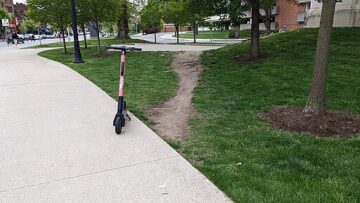by Jochen Szangolies

If you spend any time in a place with public parks, gardens, or simple green areas fenced in squarely by concrete walkways, you’ll be familiar with the sight of trampled paths cutting across the grass, tracing a muddy connection through that which the street would lead you around. Depending on your mood and disposition, you might be annoyed by the sight: can’t people spend the extra few minutes to go around? Is their time really that valuable that they desperately have to cut their walk short by a few minutes? Can’t they just, well, keep off the lawn?
Or you might have perused such shortcuts yourself. Perhaps slightly sheepishly and with a vague sense of doing something forbidden, you reasoned that going all the way around to get to the bus stop is really too much of a bother—and besides, what if you miss your bus? Better to quickly dash through; it’s not like your own footprints will do all that much to deepen the path, anyway.
Or perhaps, you paused a while to wonder. Why is there a need for such a path? Evidently, enough people at point A wanted to go to point B using the shortest route to defy city planners by voting with their feet. Why wasn’t that path there in the first place?
From this point of view, such a desire path represent a failure of top-down planning to anticipate the bottom-up reality of the person in the street, so to speak. They’re a design flaw: after all, cities and the streets traversing them are (or ought to be) designed for the convenience of the humans inhabiting them. The layout the city planners intended is not a divine law, but an all-too-human best guess at what works; and desire paths are ways to demonstrate what doesn’t, not transgressions against the way things must be. In a design perfectly attuned to human needs, desire paths would be unnecessary. It’s not the people who cut across the grass that are at fault, it’s the layout of the streets that fails to conform to human needs. Read more »
